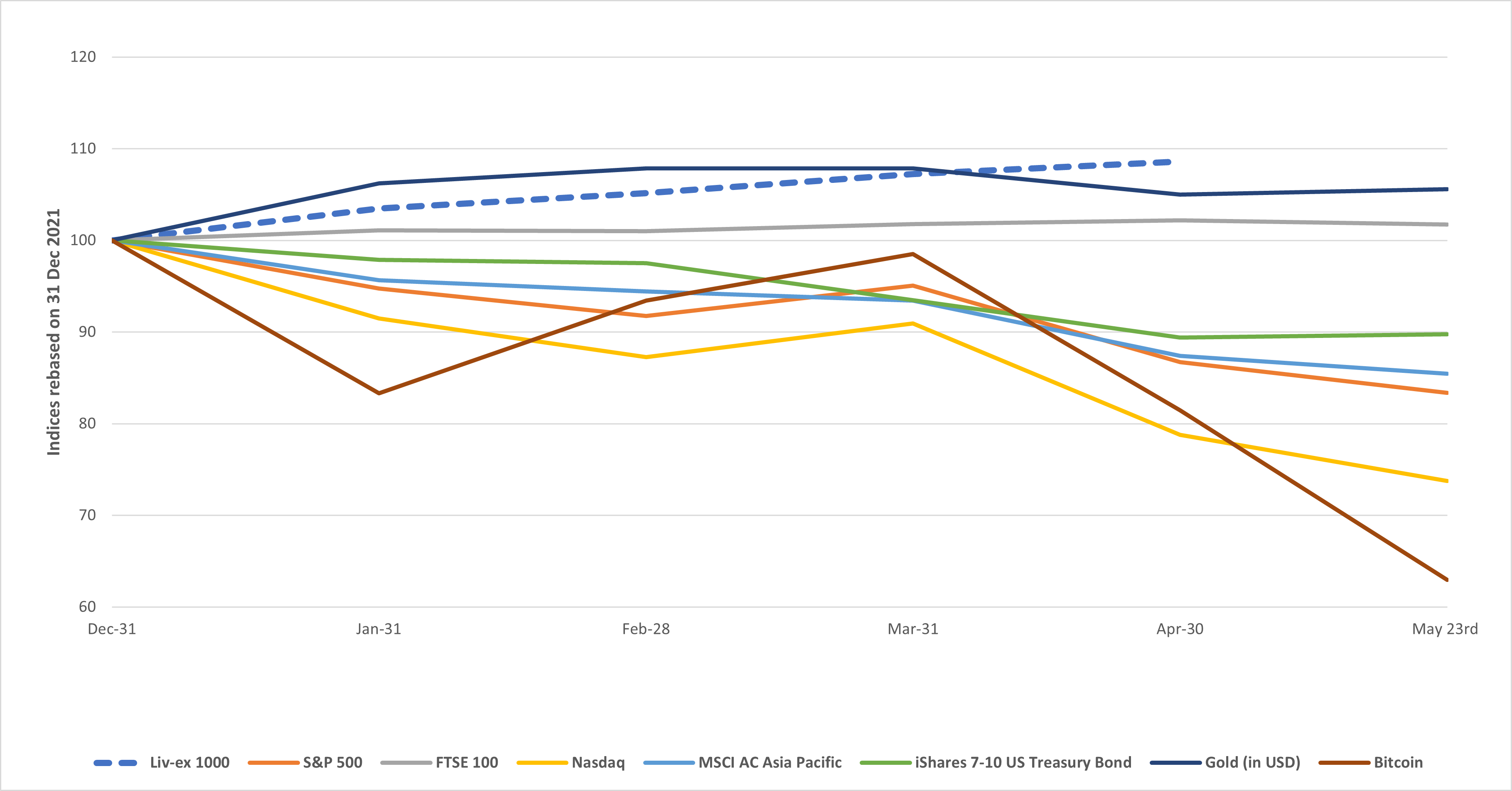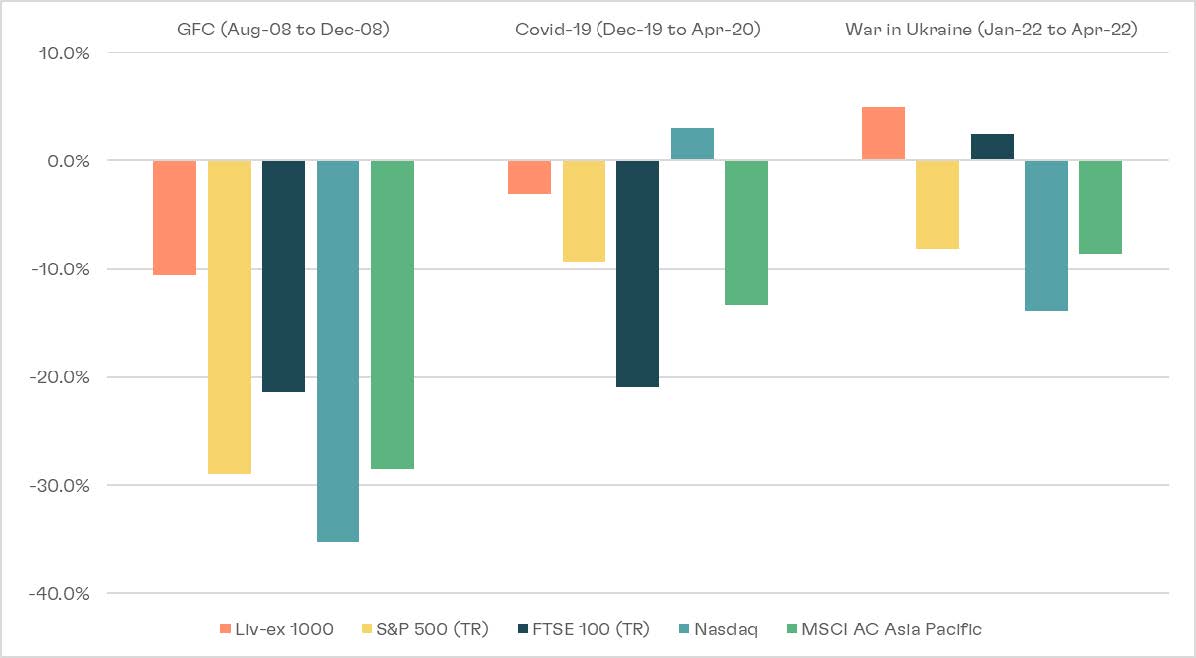
Nowhere to Hide? Fine Wine is Providing a Rare Haven in Volatile Markets.
So far, the fine wine market remains one of the few bastions of stability in an increasingly bleak investment environment. The Liv-ex 1000, the broadest measure of the global fine wine market, has returned 8.6% this year (as of 30 April), keeping alive an unbroken streak of monthly gains going back to August 2020.
These gains stand in stark contrast to most of the financial markets, where selloffs have hit a wide range of industry sectors, asset classes and geographies. The initial shock from the war in Ukraine has led to surging commodity and food prices, triggering the highest inflation in decades in several major economies. COVID policies in China have dragged on the regional market and added to global supply chain problems.
Figure 1 - Staying afloat
Fine wine vs major financial indices YTD returns percentage

*Liv-ex 1000 performance as of 30 Apr as returns calculated monthly; other indices as of 23 May. Source: Investing.com, Liv-ex. Past performance is not a guarantee of future returns.
By some accounts, the start of 2022 is the worst start for a traditional 60-40 equity/bond portfolio ever1. But even many alternative assets have provided little sanctuary. Here is a quick rundown of 2022 by asset class:
- Equities – Major equity indices are currently well below where they began the year. As recession talk in the US and other major economies grows, we may not have hit bottom yet.
- Bonds – The long bull run for bond markets appears to be over. US Treasury and other governments bonds had delivered steady returns for investors for decades, but 2022 has demonstrated how bonds do not provide safe havens during periods of high inflation and rising interest rates.
- Gold – The traditional go-to during risk-off periods, gold prices rallied earlier this year but have since given back much of their gains due to the strengthening US dollar.
- Cryptocurrencies – A very volatile year is partly linked to increased correlation to the stock market. Internal factors have also undermined confidence, such as the crash of stablecoin terraUSD sparking fear across the wider crypto space. After hitting highs over $61,000 in Q4 2021, Bitcoin has been trading under $30,000 in recent weeks.
Why has fine wine remained stable?
Fine wine’s year-to-date relative strength does not come as a surprise. During previous periods of volatility, such as the COVID-19 outbreak, fine wine prices experienced shorter and less severe downturns compared to equities and faster bounce backs compared to other haven assets, such as bonds.
Figure 2 - Relative calm during a crisis
Fine wine’s relative performance during market downturns

Source: Liv-ex, investing.com. Past performance is not a guarantee of future returns.
This track record may be contributing to fine wine’s recent performance as more buyers, whether collectors or investors, realise fine wine’s ability to form a stable store of value.
Additionally, low fine wine supply levels are also supporting prices. Low harvest yields in 2021 and 2022 have dented production levels for leading fine wine regions, including Bordeaux, Burgundy, Champagne and California, creating fierce competition for top wines.
Outlook for fine wine and the wider markets
The economic and financial market outlook remains challenging to say the least, with risk of recession in the US and other Western economies growing. Ongoing cost-of-living concerns mean central banks face the twin challenge of keeping inflation in check while supporting growth. Although they will tread carefully, the prospect of monetary policy tightening dampens hopes of a quick rebound in financial markets.
Despite its strengths, we recognise fine wine will not likely remain entirely immune forever. Fine wine’s recent soaring growth (Liv-ex 1000 +29.3% since beginning of 2021 through April 2022) would be difficult to maintain under any circumstances, and demand for fine wine could moderate as caution seeps in amid the gloomy economic picture.
However, we believe a selloff is unlikely and that fine wine market can maintain its relative stability to financial markets due to several supporting factors:
I. Inflation can exert upward pressure on fine wine prices as wine, at its core, remains a consumer product. While inflationary pressures aren’t ideal for consumers purchasing wine for near-term consumption, those holding wine stocks benefit from higher returns should prices climb over the longer term.
II. Lower liquidity – Fine wine is a less liquid market than equities, bonds, gold, and cryptocurrencies. Assets that cannot typically be sold as quickly amid a market shock helps insulate them from sharp selloffs. Consequently, fine wine can form a more reliable store of value than highly liquid assets.
III. No leverage – As a real asset, fine wine investments do not involve leverage, avoiding situations when investors are forced to sell during down markets, causing prices to drop further.
IV. Foreign exchange backdrop – A strong dollar relative to the pound and euro boosts the purchasing power of US buyers, making fine wine (typically denominated in pounds and euros) more attractive for this large market.
Trends within fine wine
So, with a slowdown possible but a reversal unlikely, the question then turns to which segments of fine wine can perform best. We’ve said before that Iconic Burgundy and select top wines from other regions that have seen huge returns recently could experience reduced demand as buyers become more cautious. But, similar to the overall market, the downside remains limited as these top tier wines will always find buyers.
Instead, the wines with the best relative value may take centre stage in the near term. Specifically, Bordeaux and Italy could see increased attention following their relative underperformance in 2021.
1Bank of America Securities study as reported in https://www.barrons.com/articles/stocks-bonds-portfolio-investing-51652394644
* Past performance is not indicative of future success; the performance was calculated in GBP and will vary in other currencies. Any investment involves risk of partial or full loss of capital. The Cult Wine Investment Performance is a hypothetical tool. The results depicted here are not based on actual trading and do not account for the annual management fees that may be charged to a Cult Wines customer which ranges from 2.95% to 2.25% depending on the size of the portfolio, and there is no guarantee of similar performance with an investor’s particular portfolio.





